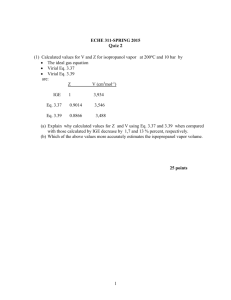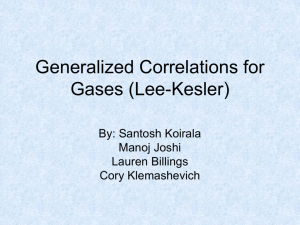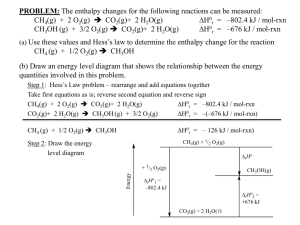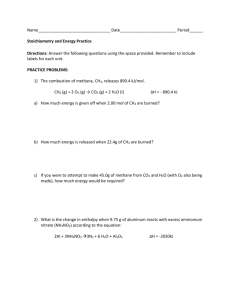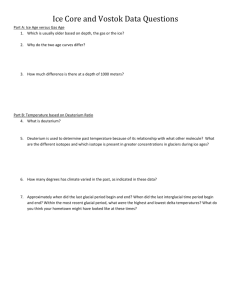Applications Intermo..
advertisement
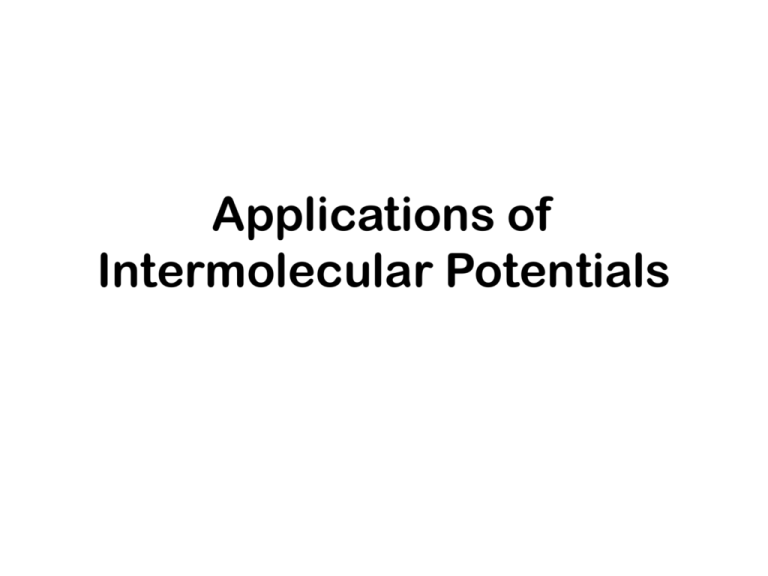
Applications of Intermolecular Potentials Example 1. A gas chromatograph is to be used to analyze CH4-CO2 mixtures. To calibrate the response of the GC, a carefully prepared mixture of known composition is used. This mixture is prepared by starting with an evacuated steel cylinder and adding CO2 until the pressure is exactly 2.5 atm at 25oC. Then CH4 is added until the pressure reaches exactly 5 atm at 25 oC. Assuming that both CO2 and CH4 are represented by the LJ 12-6 potential with the parameters given below molecule s (Å) e/k (K) CH4 4.010 142.87 CO2 4.416 192.25 s ij 12 s ij uij (r ) 4e ij r r 1 s ij s i s j ; 2 e ij e iie jj 6 What is the exact composition of the gas in the cylinder? 2 According to the Lennard-Jones (12-6) potential for non-polar molecules, the second virial Coefficient is First, based on these two equations, we can calculate the second virial coefficient of the pure CO2 species. And then we can calculate the number of molecules of CO2, N1=102.19 mol (we assume the volume is 1 m3). Using the combining rule as shown to obtain the B12 Then we can use Matlab to solve the equation of x1 so as to find the exact composition of the gas in the cylinder. Then we get x(CO2)=x1=0.5 3 Example 2. For calibration of a gas chromatograph we need to prepare a gas mixture containing exactly 0.7 mole fraction of methane and 0.3 mole fraction of CF4 at 300 K and 25 bar in a steel cylinder that is initially completely evacuated. Assume this mixture can be described by the virial EOS up to the 2nd virial coefficient, and the molecular interactions are described by the square-well potential and Lorentz-Berthelot combining rules u (rij ) if r s ij ; - e ij if s ij r RSWijs ij ; 0 if r RSWijs ij molecule s(Å) e/k (K) RSW CH4 3.400 88.8 1.85 CF4 4.103 191.1 1.48 The following procedures will be considered for making the mixture of the desired composition at the specified conditions: 1. CH4 will be added isothermally to the initially evacuated cylinder until a pressure P1 is obtained. Then CF4 will be added isothermally until 25 bar are obtained at 300K. What should P1 be to obtain exactly the desired composition? 2. CF4 will be added isothermally to the initially evacuated cylinder until a pressure P2 is obtained. Then CH4 will be added isothermally until 25 bar are obtained at 300K. What should P2 be to obtain exactly the desired composition? 4 The first step is to calculate the number of moles with a unit volume of the mixture at 25 bar. For the virial equation truncated to the 2nd virial coefficient. we know that P B 2, mix T 2 RT B2, mix T x CH 4 B2CH 4 T x CF 4 B2CF 4 T 2 x CH 4 x CF 4 B2CH 4,CF 4 T 2 2 The second virial coefficient for a square well potential is, 2s i 3 B T 1 1 e ei / kT i 1 3 i 2 B2CH 4,CF 4 T s mix combining rules for the square-well parameters: s CH 4 s CF 4 2 mix CH 4 CF 4 2 e mix e CH 4 e CF 4 5 Using SI units and assuming a vessel volume of 1 m3 the final number of moles is obtained by using Eqn. (1) Nf = 1065 moles for the final mixture (a) The amount of CH4 initially added would be 0.7Nf Since the vessel retains the same volume = N, the initial pressure with only CH4 added can be solved using eqn. : P B2i T 2 RT Pi= 18.0 bar (b) Similarly for CF4 Pi= 7.7 bar 6 Example 3. The best estimates of the relations between the critical properties and the LJ parameters are given by: N avs 3 Pcs 3 1.35; 0.35; 0.142 e Vc e kTc use these expressions to obtain the LJ parameters of CH4, CF3, Ar, and CO2 and then compute the 2nd virial coefficients for these gases over the temperature range from 200 to 800 K Critical Properties Species Tc Pc (K) (bar) CH4 190.4 45.96 CF4 227.6 37.4 Ar 150.7 48.98 CO2 304.1 73.825 L-J parameters σ ε/k (A) (K) 3.918 141.04 4.454 168.59 3.548 111.63 3.91 225.26 The second virial coefficient as a function of temperature can then be estimated by the L-J potential where y = (r/σ)3. 7 Carrying out this integration at various temperatures along the range T= 200 to 800K Second Virial Coefficients (A^3) T(K) CH4 CF4 200 -169.055 -324.061 300 -66.918 -144.13 400 -21.563 -65.414 500 3.646 -21.839 600 19.47 5.524 700 30.191 24.117 800 37.848 37.454 Ar -76.78 -21.396 3.477 17.302 25.937 31.742 35.847 CO2 -390.538 -189.512 -104.884 -58.717 -29.878 -10.289 3.797 8 Example 4. The triangular well potential is: R s r u (r ) if r s ; - e TW if s r R TWs ; 0 if r R TWs R TWs s a. Obtain an expression for the 2nd virial coefficient for this potential b. Does the 2nd virial coefficient for the triangular well potential have a maximum as a function of temperature? Region 1 (0 < r < σ): Region 2 (σ < r < Rσ): 9 Region 3 (r > Rσ): For the 2nd region: Integrating by parts: 10 Then, the complete expression for B2(T) is: b) To determine if there is a temperature at which B2 is at a maximum, take the derivative of this expression with respect to temperature and set the result equal to zero. Note that regions 1 and 3 have no temperature dependence, so there is no need to search them for a maximum. 11 If values for R, α and β were available, a more complete analysis could be done. 12
